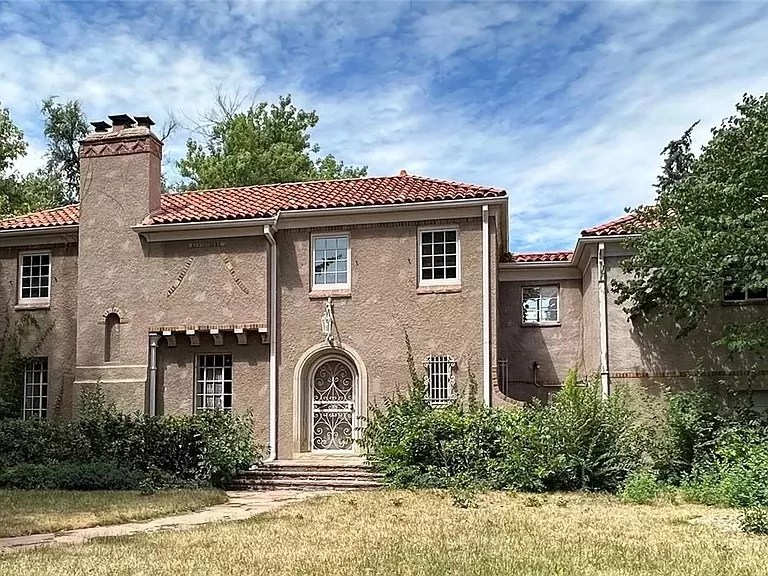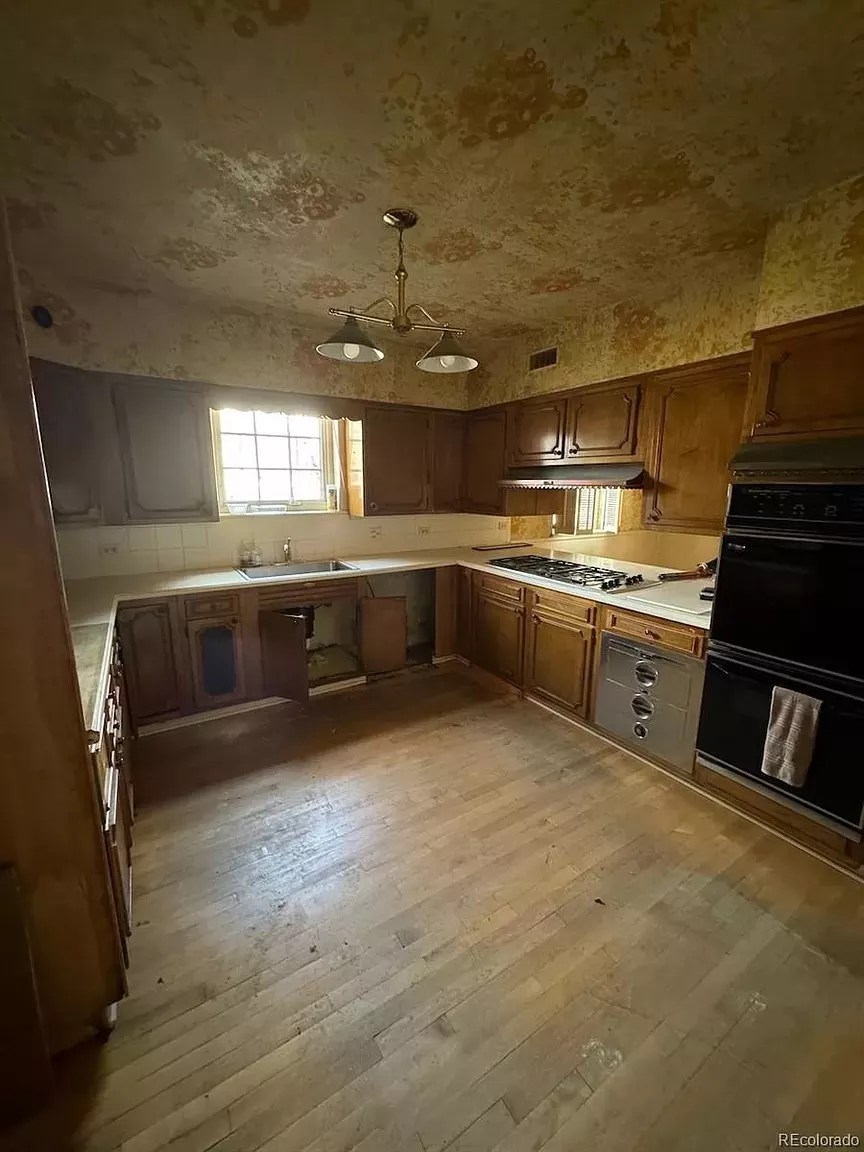
Zillow

Audio By Carbonatix
After an owner-opposed landmark application led to months of negotiations, the Park Hill property at 5013 East Montview Boulevard has hit Zillow.
The 4,581-square-foot, five-bedroom, five-bathroom house is listed for sale for $2.725 million.
“Amazing opportunity in coveted South Park Hill neighborhood!” reads the listing. “This property is a match for the preservation minded buyer that wants to renovate in one of Denver’s premier neighborhoods. With an 18,700 square foot beautiful corner lot, it provides a park like setting and lots of outdoor space. The home will need a full renovation and some of the asbestos remediation has started in the finished basement….”
“We just wanted to give them time to find somebody if there’s someone out there that wants to go and restore this house,” says Mark Rhinehart, who purchased the circa 1934 home with his wife, Marianne, through a trust in 2022. “It’s just not something that my wife and I can take on. … There’s a huge difference between doing a new build and a historic renovation.”
The Rhineharts had hoped to demolish the old house and build a forever home on the choice lot, but when their demolition company applied for permits in September, Denver Landmark Preservation flagged the property as one that could be eligible for preservation. Two months later, three nearby residents filed for landmark designation.
According to their November application, the home’s Italian Design style and construction by famous builder Douglas M. Sugg, who built high-end dwellings in Denver from 1920 to 1950, including the Clinton Bowman House, could qualify the property for designation. Some of the home’s occupants were also noteworthy: Pharmacist and theater bigwig Harry Huffman’s wife, Christine, was the first owner; attorney Robert Hawley and wife Betty purchased it in 1949. The two are described in the landmark application as a Denver “social power couple” who began their decades of influence while living at the 5013 Montview property. The home also has a visibly prominent location on Montview, which could help it qualify as a landmark
Under current city rules, once an owner-opposed application is filed, the parties must undergo mediation, then the city evaluates the application and a public hearing is scheduled at Denver City Council to make the final determination on the building’s future.
“We have ten criteria that are a variety of architectural, historical, cultural and geographic criteria,” says Abigail Christman, principal city planner for Landmark Preservation. “For a designation, a property needs to meet at least three of those ten criteria to show that they have various areas of significance.”
Christman notes that the department has yet to make its official determination on whether this building fits three or more criteria. But in the meantime, the Rhineharts and the neighbors who filed the landmark application – Margaret McRoberts, Trish Leary and Bernadette Kelly, with the help of nonprofit Historic Denver – have been negotiating over the property’s fate.
In late December, in a compromise with the applicants, the Rhineharts agreed to look for a preservation-minded buyer. That put the designation process on a 45-day pause that will end in late January.
“We understand that some members of the community would prefer to see the house preserved in its current state, but regrettably, we lack the capacity and time to undertake the intricacies of a historic renovation project,” Rhinehart wrote in the Park Hill Facebook group. “The stress of this process has become overwhelming and we recognize our limitations in handling something of this complexity.”
He explained that because such a project is beyond their capabilities, they’re up for selling at the right price. The couple spent $2.5 million on the property in 2022, nearly $87,000 for architects and permits, and another $14,000 in legal fees. That accounts for the sale price of $2.7 million, according to Rhinehart.

The property’s owners say it needs too much work.
Zillow
If a buyer comes forward, the Rhineharts will bow out. If not, they plan to ask the applicants to consider withdrawing their landmark application. Although owner-opposed landmark applications are rare – the city only identified nine buildings that could be designated from the over 400 demolition applications it received in 2023 – those designations capture plenty of attention. Tom’s Diner garnered public outcry in 2021 when an owner-opposed landmark application was filed on the property at 601 East Colfax Avenue; it was withdrawn after a preservation-minded buyer stepped in. The building was subsequently renovated and reopened as Tom’s Starlight in August 2022. But it closed in November, and the space is now for lease.
In the wake of the Tom’s Diner controversy, Denver City Council changed the process for owner-opposed applications to be more fair for owners. Before, they would get just three minutes to argue their case before Denver City Council while Landmark Preservation staffers could make a full presentation about why it should become a landmark. Now, property owners get the chance to make as extensive a presentation, as do the residents who file hostile applications.
If an owner wants to have a property designated a landmark, there’s a $250 fee. Owner-opposed applications require an $875 fee.
Councilmembers Kendra Black, Kevin Flynn and Amanda Sawyer developed the new rules in 2022. Black is no longer on council, but both Flynn and Sawyer say the changes were a matter of basic fairness.
“Often it would be in a public hearing where maybe fifteen people signed up, and fourteen were in favor and only the owner whose property rights were going to be impacted was opposed,” Flynn recalls. “It was manifestly an unfair process.”
Sawyer says her district is very active in recognizing landmarks, and when everyone agrees, it’s a good thing – but that’s not always the case.
“The owner-supported historic designations are fun,” she says. “They’re great. They’re happy moments where we’re preserving pieces of the city’s history which were really, really important, and the owner recognizes some of the hurdles and challenges and expenses that come with historic designation and are willing to do that, anyway. … Those hearings are awesome. It is the owner-opposed hearings that are awful for us, because they are just really ugly.”
Owner-opposed designations clash with personal property rights, she adds, so the city needed to create a better balance to ensure due process for the owners. So far, she thinks the change has been positive.
There have been two public hearings on owner-opposed landmark applications under the new rules. A property at 1741 Gaylord Street was designated against the owner’s wishes – marking only the second time such an outcome occurred – and council is now being sued by the owner. The other was not designated.
“It’s a much more fair process for everybody, because we don’t limit the proponents or the opponents to their three-minute spiel at the podium,” Flynn says. “An owner-opposed designation, I believe, requires that we more intentionally look at the criteria and the circumstances.”
Flynn suggests that when the owner wants a building designated, there is less examination of its true historic value – so owner-opposed designations under the new rules could lead to better designations overall.
Sawyer agrees. “We all have a duty to preserve this history,” she says. “It’s just how do we do it in a way that is fair, that is just, that is right, that takes everyone into account?”
In this case, though, they hope the Montview property won’t be the subject of a contested public hearing in front of council.
“The reality is that it takes time, money, resources and know-how,” Rhinehart says of preserving old homes. “We’re just holding open the opportunity that there’s somebody out there to do that who’s the right person for it.”